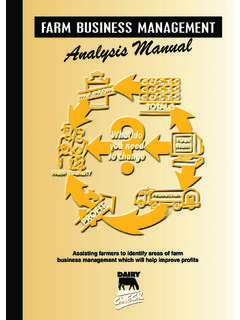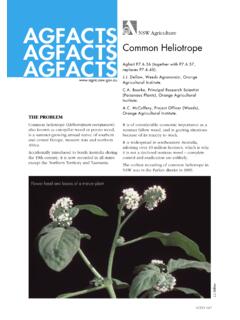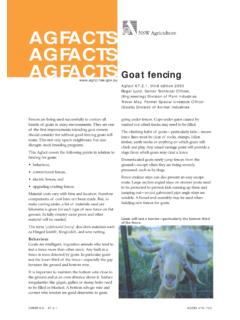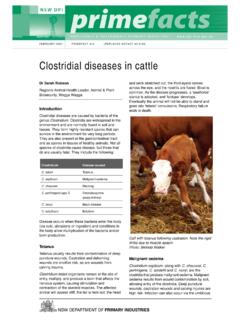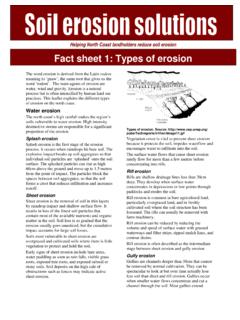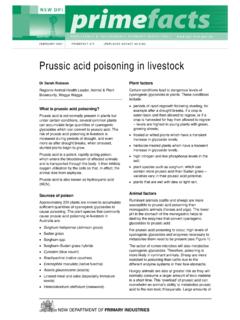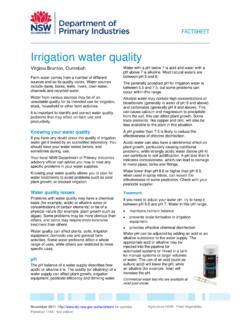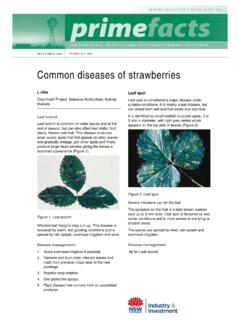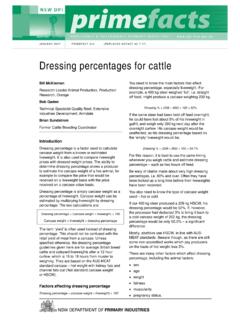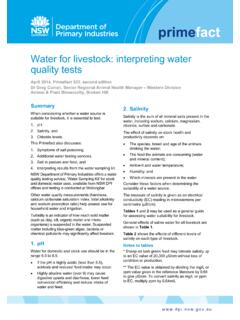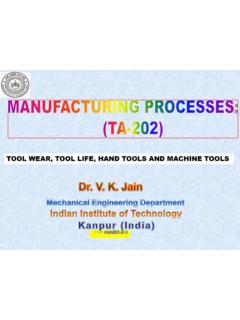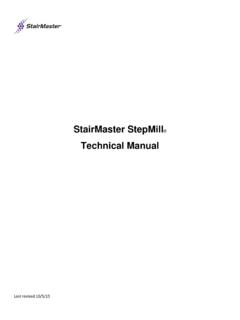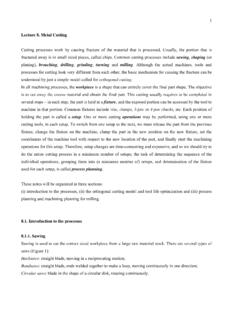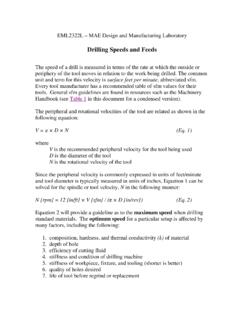Transcription of Guide to machinery costs and contract rates
1 SEPTEMBER 2009 PRIMEFACT 913 (REPLACES AGFACT ) Guide to machinery costs and contract ratesSalahadin Khairo Economist Trangie Agricultural Research Centre, Trangie Lloyd Davies Economist, Tocal Agricultural Centre, Paterson Introduction This Primefact has three aims: to alert farmers to the real costs of owning and operating machinery ; to explain how contract rates are calculated, for those farmers deciding whether they should buy a piece of machinery or contract someone else's; and to assist those farmers wanting to contract out machinery by showing them how to properly calculate their costs . This will help them arrive at a fair and realistic fee. Commonly, farmers wanting extra income will contract out their machinery but they tend to undercharge. Fixed costs (ownership costs ) Fixed costs are costs which don't vary with usage.
2 You pay these costs every year regardless of whether you use your machine for 10 hours or 1,000 hours. Examples of costs associated with owning machines are insurance, depreciation, interest (opportunity) cost , shedding, workshop and registration costs . Insurance Not all people insure their machinery separately; it is often covered by an overall farm insurance policy. Usually only self-propelled machinery would be insured separately, not tillage equipment. A rule of thumb for estimating a machine 's insurance cost is $10 for every $1,000 of the machine 's average value (in other words 1%), but if you know the actual insurance cost for your machine then use that figure instead. Estimated insurance cost /year = av. value 100 Depreciation Depreciation is the decrease in a machine 's value over time. It is the amount of money you must put away every year to be able to replace the machine at the end of its expected life .
3 Depreciation claimed for tax deductions must use either the 'straight line' depreciation method or the 'diminishing value' method. The depreciation rate for these methods is based on effective life . This is normally specified by the tax office but you can choose a different effective life if you can give the tax office a reasonable argument for variation. The straight line depreciation method is the simplest way to estimate your machinery 's depreciation. It distributes the decrease in the value of the machine over its lifetime. Take the price of a new machine (ignoring price differences due to any trade-in deals), subtract whatever price you would get for it at the end of its expected life , and divide by the number of years of use: Depreciation cost = (new price - trade-in price) number of years used Note: Complete calculations inside brackets first.
4 If you think the machine will have no value at the end of its working life then the trade-in price will be zero and the depreciation is just the current cost to replace the machine divided by its life expectancy. If the machine loses more value in particular years and you want your contract rate to reflect these differences then you will have to estimate the depreciation for each year of its expected life . This 2 PRIMEFACT 913, Guide TO machinery costs AND contract rates is done by estimating a market value at the start of the year and the end of the year. The difference is the depreciation rate to be used for that year. If you use the market value method, the resultant contract rate you calculate will be higher in early years of machinery ownership and lower later on because a machine loses more value in its early years than in later years.
5 This could cause confusion with clients and therefore a straight line depreciating system is suggested. Interest cost An interest cost (or opportunity cost ) is the cost of using money. If you had invested your money instead of using it to buy the machine , it would have generated income. The interest cost we use in this situation is generally what could be earned with a bank deposit but if there are alternative investments that would earn a higher rate, the higher rate could be used. In other situations the contractor will be borrowing to finance the purchase of the machinery and in this case the interest rate charged by the lender is used. Interest cost = average value x interest rate Average value = (new price + trade in value) 2 For example if you buy a tractor for $60,824 and sell it later for $27,300 then the average value is half way between the purchase price and the selling price.
6 Average value = ($60,824 + $27,300) 2 = $44,062 Interest cost = $44,062 x 10% = $4,406 (assuming an interest cost of 10%) Note: Make calculations inside brackets first. Shedding cost This is the cost associated with having a shed on your property which is used primarily to house your machinery . As a rule of thumb, an annual charge of 1% of the purchase price of the machine is often used as an estimate of the cost of shelter. Shedding cost = price of new machine 200 Alternatively, you can work out the depreciation cost of owning the shed and the proportion of the shed devoted to that machine ; the shedding cost is the proportion of shed used by the machine multiplied by the yearly depreciation cost of the shed: Shedding cost = yearly depreciation of shed x proportion of shed used by the machine Workshop cost If the machine is serviced and repaired on the farm, then a proportion of the depreciation and interest costs of the tools and workshop are due to the machine .
7 The proportion depends on the time spent working on the machine in relation to the total time spent in the workshop or using the tools: Workshop cost = proportion of workshop time used for machine x cost (depreciation & interest) of workshop and tools Registration cost If you are going to drive your machinery (say, a tractor) on the road you will incur a yearly registration cost . If you travel longer distances you may also have registration costs of a truck or a trailer to consider. In general, registration costs for a truck or trailer would only be included when contracting is the main reason for the expense. You can attribute a proportion of truck or trailer registration costs equivalent to the proportion of use in the contracting operation. Registration cost = cost to register tractor (if applicable) + ( cost to register truck or float x proportion of use) Implements Implements are generally assumed not to have an insurance cost , but generally do have depreciation and interest costs .
8 These are worked out as shown under 'Depreciation' and 'Interest cost ': Depreciation cost (implements) = (new price - trade-in price) number of years used Interest cost (implements) = average value x interest rate. Estimating ownership costs on an hourly basis To estimate what a yearly cost is on a 'per hour' basis, you must divide the yearly cost by the number of hours per year spent using the machine . Because of this, the more hours per year you work the machine , the lower your hourly cost will be. The number of hours per year your machine works will also affect its life expectancy and trade-in value, but these also depend on other things, such as maintenance and the type of work it performs. The more accurate your estimate of the amount of work your machine will do, the more accurate your estimate of costs will be.
9 To be on the safe side you should be conservative with your estimate of work (particularly if the work is not guaranteed) and with your estimates of trade-in value and working life of your machine . Variable costs (operating costs ) Variable costs are those costs which vary in proportion to the machine 's use. They are sometimes called operating costs , because they occur only when the machine is operated. The main variable costs for tractors and headers are fuel, oil, filters, tyres, tubes, batteries and repairs. For implements and other non-engine operated machinery , variable costs can be loosely taken as repair costs . Variable costs can be accurately estimated if good machinery records are kept. Instruction manuals sometimes give information on typical fuel and oil usage and also expected life of any moving parts on the machine .
10 Fuel, oil and grease, and wearing parts Fuel use varies proportionally with the power of the engine, and is affected by the loading. A rule of thumb for tractor fuel usage in L/hr under normal working conditions is: the pto power in kW divided by 4. Filter life can be obtained from the retailers but their costs are significant and should not be ignored. Fuel costs are included in the contract rate calculation and it has been assumed in Tables 2 and 3 that the contractor is not entitled to Federal diesel rebates. Full-time contractors are unable to claim this rebate. Rebates and subsidies Petroleum product subsidy scheme Phone: 1300 305 191* Fax: (02) 9689 6345 Email: For information on the Federal Rebates and subsidies contact: Diesel Fuel Rebate Section GPO Box 4042, Sydney NSW 2001 Phone: 1300 305 191* Fax: (02) 9689 6345 Alternatively, you can test your eligibility for a rebate by using the fuel tax credit eligibility tool .
